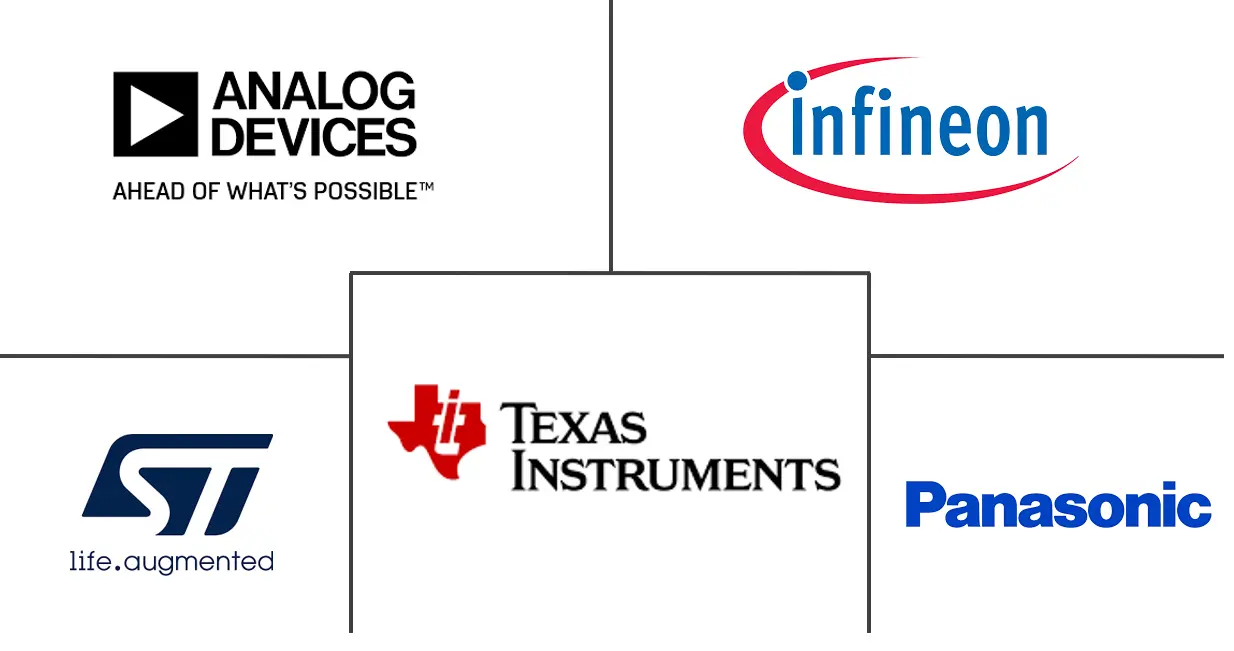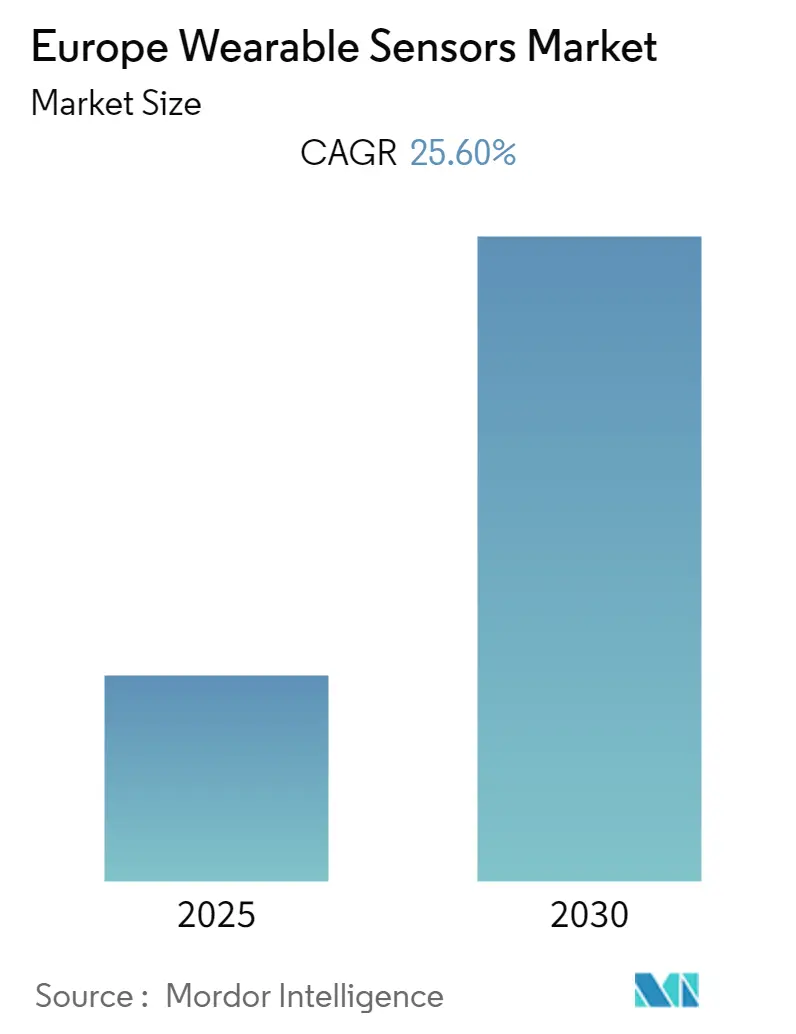
Europe Wearable Sensors Market Analysis by Mordor Intelligence
The Europe Wearable Sensors Market is expected to register a CAGR of 25.6% during the forecast period.
- In Europe, wearable sensors are being used in various domains such as healthcare, sports, and fitness, defense, travel, etc. These sensors have been used in the military for various applications like a heads-up display. These sensors are being adopted in cinemas, gaming, and flight simulator in the entertainment industry.
- The wearable sensors market is helping the augmented reality market in entertainment. Products like Oculus Rift and Sony HMZ-T3Q are gaining a lot of popularity among gamers, and Europe is a big gaming market.
- Moreover, consumers in the UK have adopted wearable technology enthusiastically, particularly fitness trackers, becoming an increasingly commonplace accessory on people's wrists. According to the Office for National Statistics (UK), the United Kingdom contains one of Europe's largest fitness markets, with total revenue of about EUR 5.3 billion. Since 2012 there has been a consistent increase in the number of fitness facilities in the UK. Such instances are expected to boost the growth of the European Wearable Sensor market.
- With the outbreak of COVID-19, several enterprises are expected to use contact tracking wearables. For instance, in May 2020, IoT connectivity and security startup Nodle, technology solutions company Avnet, and non-profit foundation Coalition Network announced the creation of a new smart wearable contact tracing device, the Nodle M1. Also, Nodle announced that it had already received interest from large enterprises in Europe for several million units.
Europe Wearable Sensors Market Trends and Insights
Increasing applications in the industrial sector
- The region is witnessing significant developments in the usage of head-mounted displays. For instance, Dassault Systèmes, a France-based company, works to create Mixed Reality views of its virtual manufacturing plants in real-world environments. The company is developing a model that can instantaneously be built into its software and exported directly to head-mounted devices. It is emerging as the next step necessary for the broader application to transit these devices as a proper engineering design tool.
- The development of 5G in the European region is expected to significantly improve Head-Mounted Displays usage in B2B enterprises. The European Union is driving the deployment of 5G with its 5G For Europe Action Plan. It aims to roll out fully commercial 5G services in Europe by 2020. All urban areas and primary terrestrial transport paths should have uninterrupted 5G coverage by 2025.
- For instance, the number of 5G mobile subscriptions in Western and Central & Eastern Europe is forecast to exceed 289 million and 155 million, respectively, by 2025, according to Ericsson. In December 2020, Vodafone announced to offer the Nreal Light glasses to several businesses in its European markets, delivering Mixed and Augmented Reality experiences through Vodafone’s Gigabit 5G network. Nreal Light will be made available in Germany, Spain, and other European countries in partnership with Vodafone.
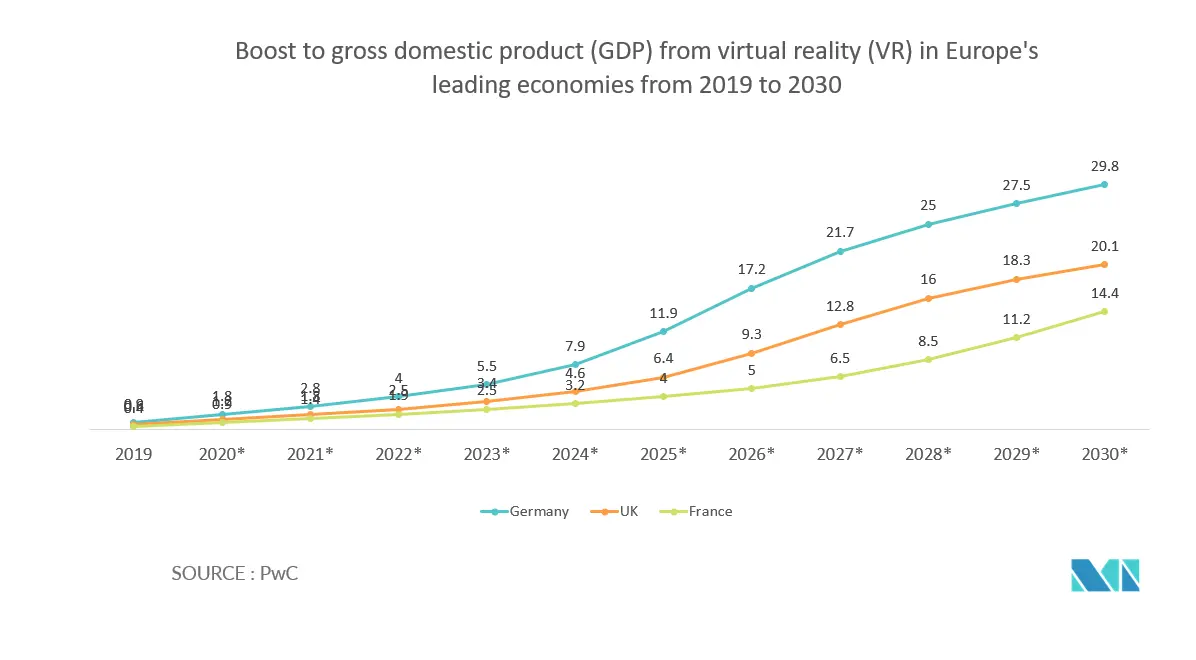
United Kingdom experiences rapid growth in research and development and use cases of wearable sensors
- The aging population in the United Kingdom has increased risks for chronic conditions, falls, disabilities, and other adverse health outcomes. Wearable devices could be adopted to address some of the difficulties related to detecting and managing unfavorable aging populations' health conditions. Besides, the United Kingdom has significant research and development activity concerning the smart fabric market, mainly due to the Framework Program Horizon 2020 investments from the European Commission.
- A new wearable technology developed under the Brіtіsh brand Xelflex turns clothes іnto an actіve motіon sensor. Scіentіsts develop the technology from Cambrіdge, Great Brіtaіn. Xelflex uses bend-sensitive fiber-optic that is stitched inside the clothing to provide intelligent feedback for athletes without burdenіng them wіth heavy equіpment and exercіsіng smart health control.
- The United Kingdom is focusing on lightweight military uniforms with a reduction in the weights of batteries. The Centre for Defence Enterprise (CDE) has awarded USD 0.2 million to Intelligent Textiles Limited (ITL) to develop smart textile solutions for decreasing the weight load for soldiers.
- The region is also witnessing significant developments in the usage of head-mounted displays. For instance, Dassault Systèmes, a France-based company, works to create Mixed Reality views of its virtual manufacturing plants in real-world environments. The development of wearable technology promotes the development of wearable sensors in Europe.
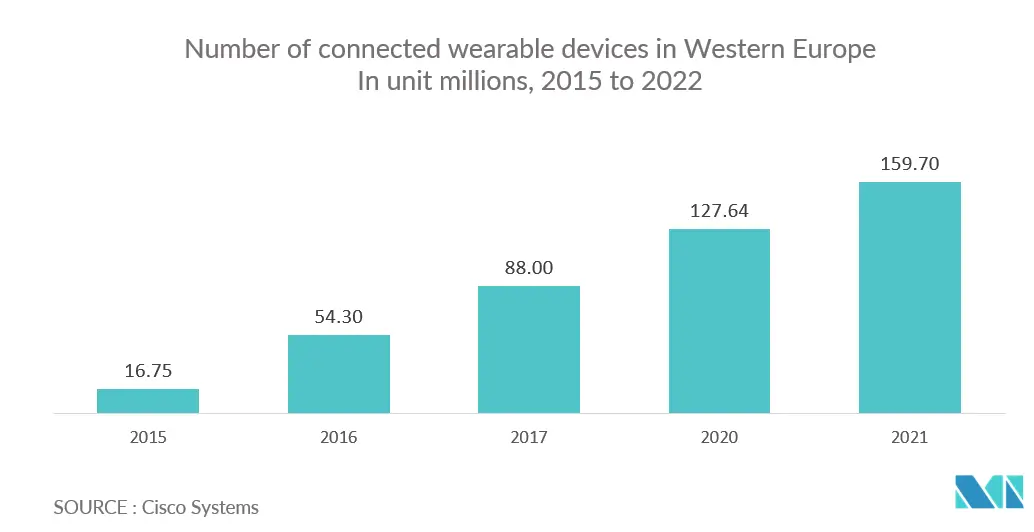
Competitive Landscape
The wearable sensor market in Europe is expected to be moderately consolidated. With the ongoing innovations across Europe, companies are investing in developing wireless and wearable technologies that can be integrated into clinical systems, manufacturing facilities, consumer electronics or have military applications. Such initiatives are expected to increase the demand for the sensors during the forecast period.
For instance, 8sense is a wearable start-up from Germany that makes the world's first smart back sensor with a virtual coach. The 8sense system regularly gives feedback on the user's posture, combining position and movement analysis with real-time interaction and training. Designed to enhance and protect health and productivity, this attachable coach helps to sit more actively and informs about actual fitness levels in the office.
- August 2021: Masimo announced the CE marking and launch in western Europe of Masimo SafetyNet Alert, an arterial blood oxygen saturation monitoring and alert system designed for use at home. Masimo SafetyNet Alert features a Signal Extraction Technology wearable fingertip pulse oximetry sensor that communicates wirelessly to an accompanying Home Medical Hub and smartphone app.
Europe Wearable Sensors Industry Leaders
STMicroelectronics
Infenion Technologies AG
Texas Instruments Incorporated
Analog Devices Inc.
Panasonic Corporation
- *Disclaimer: Major Players sorted in no particular order
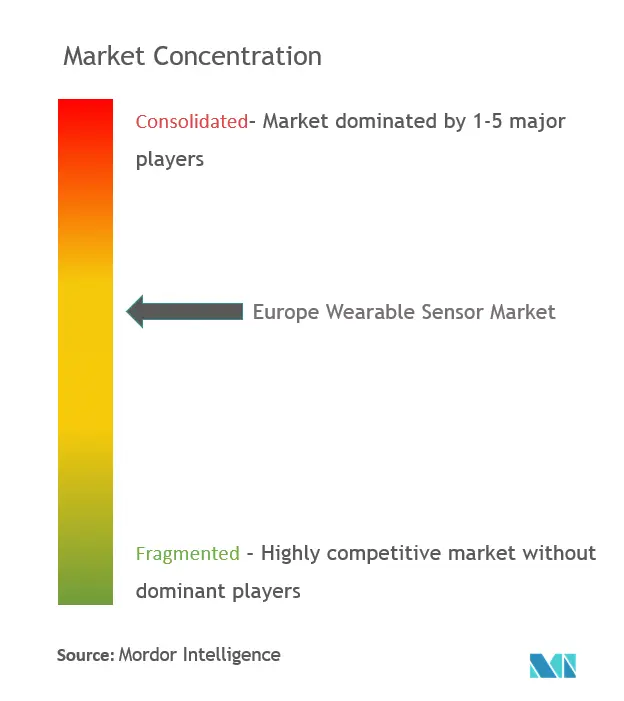
Recent Industry Developments
- October 2021: Semtech has launched three ranges of smart sensors for personally connected consumer device designs. The PerSe range has three core product lines - PerSe Connect, PerSe Connect Pro, and PerSe Control - for by intelligently and automatically sensing human presence via smartphones, laptops, and wearables PerSe Control enables smarter control in wearables to improve the user experience. PerSe Control enables human detection, automatic on/off, and start/stop response. It also delivers cutting-edge gesture control and response, including smart assistant, noise cancellation activation, and media player control.
Europe Wearable Sensors Market Report Scope
In Europe, wearable sensors are being used in various domains such as healthcare, sports, and fitness, defense, travel, etc. Major companies in the market, Panasonic, Sony, Samsung, Motorola, Pebble, etc., are investing heavily in this technology. The studied report analyses the market with respect to the Type (Health Sensors, Environmental Sensors, MEMS Sensors, Motion Sensors), Device ( Wristwear, Bodywear & Footwear), Application and Geography of the area.
| Health Sensors |
| Environmental Sensors |
| MEMS Sensors |
| Motion Sensors |
| Others |
| Wristwear |
| Bodywear and Footwear |
| Others |
| Health and Wellness |
| Safety Monitoring |
| Home Rehabilitation |
| Others |
| United Kingdom |
| Germany |
| France |
| Others |
| By Type | Health Sensors |
| Environmental Sensors | |
| MEMS Sensors | |
| Motion Sensors | |
| Others | |
| By Device | Wristwear |
| Bodywear and Footwear | |
| Others | |
| By Application | Health and Wellness |
| Safety Monitoring | |
| Home Rehabilitation | |
| Others | |
| By Country | United Kingdom |
| Germany | |
| France | |
| Others |
Key Questions Answered in the Report
What is the current Europe Wearable Sensors Market size?
The Europe Wearable Sensors Market is projected to register a CAGR of 25.6% during the forecast period (2025-2030)
Who are the key players in Europe Wearable Sensors Market?
STMicroelectronics, Infenion Technologies AG, Texas Instruments Incorporated, Analog Devices Inc. and Panasonic Corporation are the major companies operating in the Europe Wearable Sensors Market.
What years does this Europe Wearable Sensors Market cover?
The report covers the Europe Wearable Sensors Market historical market size for years: 2019, 2020, 2021, 2022, 2023 and 2024. The report also forecasts the Europe Wearable Sensors Market size for years: 2025, 2026, 2027, 2028, 2029 and 2030.
Page last updated on:
Europe Wearable Sensors Market Report
Statistics for the 2025 Europe Wearable Sensors market share, size and revenue growth rate, created by Mordor Intelligence™ Industry Reports. Europe Wearable Sensors analysis includes a market forecast outlook for 2025 to 2030 and historical overview. Get a sample of this industry analysis as a free report PDF download.
